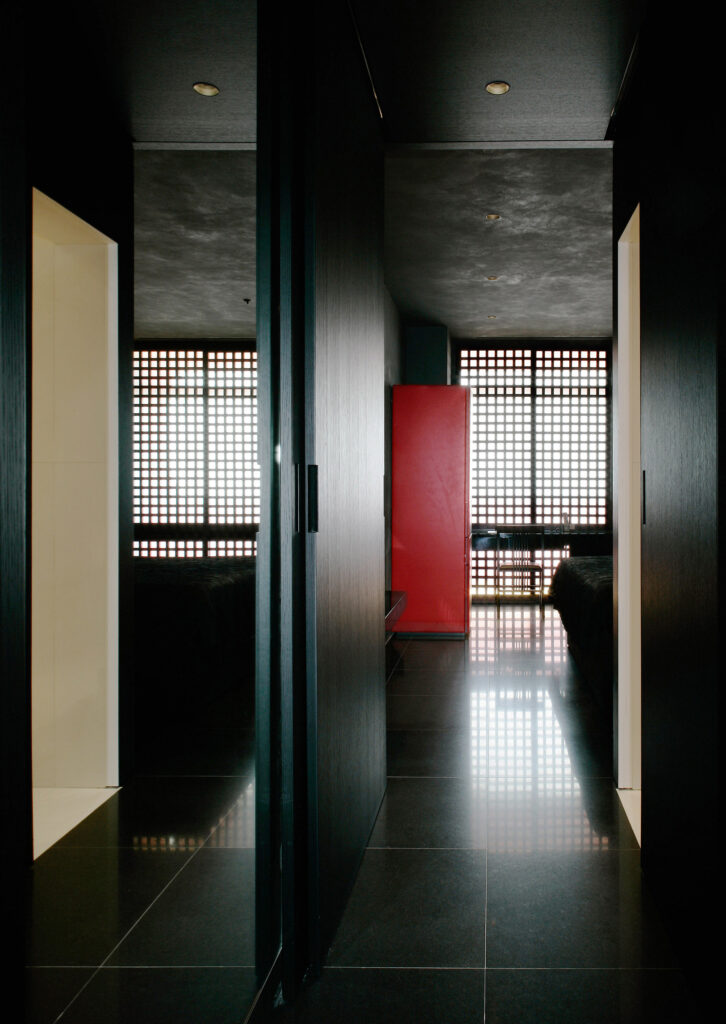
Hotel Puerta America
10 Floor
Hotel Interior design
Madrid, Spain
2003
Project Architect: Arata Isozaki & Associates
Client: Hoteles SIlken
Contract: B&B Italia
The configuration of space begins with an almost tactile approach to the world, an intense, long, slow and gradual way of reaching objects. Light is acceleration of perception, shadow is slowness, deceleration of what is perceived. Space is a composition of shadows. His scene is not saturated with objects but rather appears ambiguous, diluted, diffuse.
The exterior light enters filtered by a shoji, a wood and paper screen; from there begins a play of faint shadows that creates continuity between the materials and amalgamates them without differentiating them.

Hotel Puerta America
10 Floor
Hotel Interior design
Madrid, Spain
2003
Project Architect: Arata Isozaki & Associates
Client: Hoteles SIlken
Contract: B&B Italia
The configuration of space begins with an almost tactile approach to the world, an intense, long, slow and gradual way of reaching objects. Light is acceleration of perception, shadow is slowness, deceleration of what is perceived. Space is a composition of shadows. His scene is not saturated with objects but rather appears ambiguous, diluted, diffuse.
The exterior light enters filtered by a shoji, a wood and paper screen; from there begins a play of faint shadows that creates continuity between the materials and amalgamates them without differentiating them.

The dominant aesthetic is one of darkness: black zimbawe granite for the floor, tsuchikabe (dark stucco with an irregular texture) for the walls and ceilings, and then black oak, lacquered surfaces, lead panels and glossy fabrics. In this subdued and worn light, the dark tones blend seamlessly with the red skin of the furniture. The chairs and tables in black wood and leather are from the Monroe series, designed in 1966.
The same idea of modulation of light is applied in the combination of materials in the bathroom area. Soft, light, almost immaterial tones: white Sivec for surfaces and Hinoki for accessories. Hinoki is a wood that, in the Japanese tradition, has always been associated with the pleasure of life, luxury and well-being. It is easy to work with, yet tough and resistant to Japan’s harsh weather. Its pale color, the scarce presence of streaks, its soft texture and especially its perfume have always been highly valued.
The dominant aesthetic is one of darkness: black zimbawe granite for the floor, tsuchikabe (dark stucco with an irregular texture) for the walls and ceilings, and then black oak, lacquered surfaces, lead panels and glossy fabrics. In this subdued and worn light, the dark tones blend seamlessly with the red skin of the furniture. The chairs and tables in black wood and leather are from the Monroe series, designed in 1966.
The same idea of modulation of light is applied in the combination of materials in the bathroom area. Soft, light, almost immaterial tones: white Sivec for surfaces and Hinoki for accessories. Hinoki is a wood that, in the Japanese tradition, has always been associated with the pleasure of life, luxury and well-being. It is easy to work with, yet tough and resistant to Japan’s harsh weather. Its pale color, the scarce presence of streaks, its soft texture and especially its perfume have always been highly valued.


The dominant aesthetic is one of darkness: black zimbawe granite for the floor, tsuchikabe (dark stucco with an irregular texture) for the walls and ceilings, and then black oak, lacquered surfaces, lead panels and glossy fabrics. In this subdued and worn light, the dark tones blend seamlessly with the red skin of the furniture. The chairs and tables in black wood and leather are from the Monroe series, designed in 1966.
The same idea of modulation of light is applied in the combination of materials in the bathroom area. Soft, light, almost immaterial tones: white Sivec for surfaces and Hinoki for accessories. Hinoki is a wood that, in the Japanese tradition, has always been associated with the pleasure of life, luxury and well-being. It is easy to work with, yet tough and resistant to Japan’s harsh weather. Its pale color, the scarce presence of streaks, its soft texture and especially its perfume have always been highly valued.


“Space is a composition
of shadows.”




“Space is a composition of shadows.”

